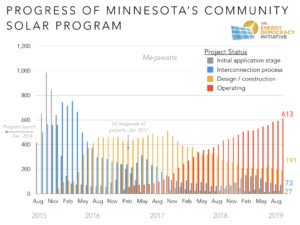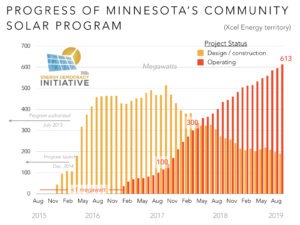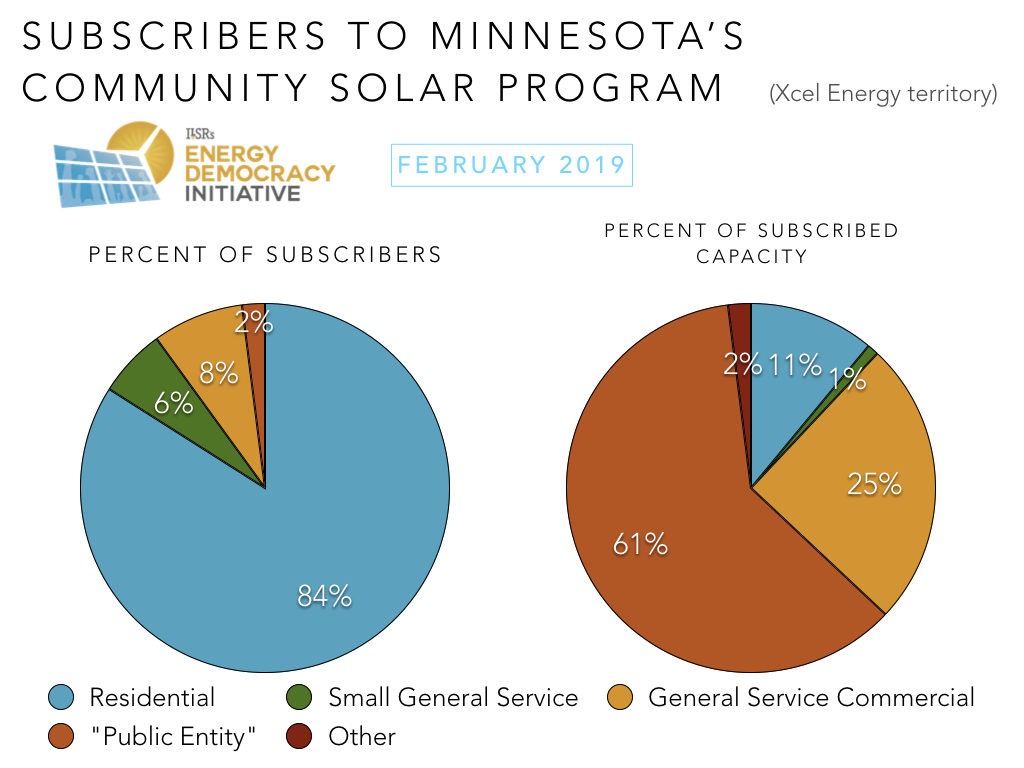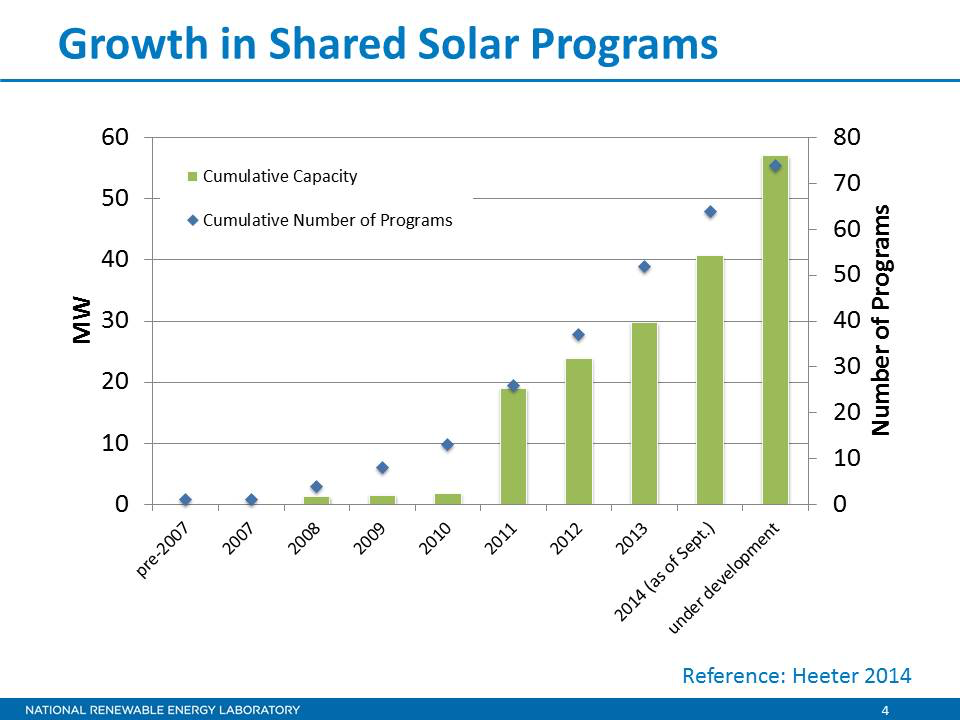Why Minnesota’s Community Solar Program Is The Best
Credit to Author: John Farrell| Date: Mon, 23 Sep 2019 19:05:03 +0000
Published on September 23rd, 2019 | by John Farrell
September 23rd, 2019 by John Farrell
Originally posted at . Updated monthly around the 15th.
Minnesota’s community solar program hit a record 613 megawatts of operational capacity in September 2019. The chart below shows the progress of projects through the program since August 2015, and the nearly two-year lag between the program launch in December 2014 and the successful ignition of multiple megawatts of capacity in January 2017.
 Data from Xcel Energy shows that bill credits for all customers totaled more than $2.2 million in February, for 17.3 million kilowatt-hours. Based on the 2018 approved value of solar, the energy was worth at least $2.2 million. According to ILSR’s analysis, all customers (subscribers or not) are seeing financial benefits from community solar. The $2.2 million figure does not include factoring in the distribution capacity value of solar nor the potential volatility of gas prices that are avoided, nor does it include the benefits of shifting wealth from power generation ownership away from a private monopoly and to a broad set of subscribers across the state.
Data from Xcel Energy shows that bill credits for all customers totaled more than $2.2 million in February, for 17.3 million kilowatt-hours. Based on the 2018 approved value of solar, the energy was worth at least $2.2 million. According to ILSR’s analysis, all customers (subscribers or not) are seeing financial benefits from community solar. The $2.2 million figure does not include factoring in the distribution capacity value of solar nor the potential volatility of gas prices that are avoided, nor does it include the benefits of shifting wealth from power generation ownership away from a private monopoly and to a broad set of subscribers across the state.
For more on the benefits of community solar, check out a new report released in May 2019: Minnesota’s Solar Gardens: the Status and Benefits of Community Solar
In April 2019, Xcel Energy proposed changes to how it is required to report community solar program information through a new online dashboard that the utility would make available on its website. ILSR signed on to comments to the Minnesota Public Utilities Commission in support of this proposed reporting change, which could help increase transparency and accessibility of community solar data. In addition, such a tool would provide a useful model as a growing number of states pass policies to expand shared renewable programs across the country.
In October 2018, the Minnesota Public Utilities Commission approved an adder to compensation rates for residential subscribers, boosting subscriptions by 1.5 cents per kilowatt-hour for projects started in 2019 or 2020. It’s hard to say definitively, but the project queue (including new applications, projects in study, projects in design/construction, and energized projects) rebounded to over 900 megawatts by December 1st, after falling from about 950 megawatts in January 2017 to about 800 megawatts earlier this year. The adder will come on top of the revised compensation scheme for new projects in 2018––based on the value of solar.
Below is a simplified version of the chart above, showing just projects in the design/construction phase or in operation.
As Xcel Energy publishes data on the mix of subscribers, we can report that more than 12,000 residential customers (84% of all subscribers) are saving money with a shared solar subscription.
While most of the program’s total capacity continues to serve commercial customers (87%), a majority of that total capacity (61% or 198 megawatts out of 325 megawatts) now notably serves public entities (up from one-third or about 100 megawatts of the total program capacity in March 2018). These public entities include schools, colleges, hospitals, and county and local governments, as outlined in Xcel Energy’s 2018 Annual Operations Report (April 2019).
In other words, community solar helps broaden those who benefit from solar by enabling individuals and public institutions to save money with solar! We’ll continue providing these subscriber spreads month-by-month if Xcel keeps reporting them.
I’ve been asked a lot of questions about Minnesota’s community solar program over the past couple years and it’s time to make one thing clear: Minnesota’s program is the best in the country.
Why? Because there 10 times more community solar projects in the queue—400 megawatts—in Minnesota than have been built in the history of community solar in the United States (40 megawatts).
Minnesota’s program (see infographic) is a comprehensive approach that makes developing community solar projects economically viable and—most importantly—that does not cap the development of community solar projects. The latter is the key.
Colorado’s landmark community solar legislation, for example, caps the program at 6.5 megawatts per utility per year (although there’s hope it may increase in the future). Massachusetts has just revamped their solar renewable energy credit program to make community solar a better investment. No other state has had significant community solar development, despite 11 states that have some form of virtual net metering that allows for sharing electricity output from an off-site solar energy project.
How big is Minnesota’s projected success?
Xcel Energy’s queue for community solar already has 20 times more solar in it than the state had installed at the end of 2014. If it all gets built, it would be enough to rank second in the country in annual solar installations in 2014.
I recently wrote that a state’s solar market can’t really launch without third party ownership—leasing or power purchase agreements that allow home and business owners to install solar with zero upfront cost, hand off maintenance concerns, and save money from day one. Indiana was the only potential exception, due to a (now defunct) feed-in tariff program operated by Indianapolis Power and Light. Minnesota may be the second.
I’m no stranger to community solar programs. I worked closely with advocates in Minnesota on the legislation, as part of a suite of pro-solar policies that passed in 2013. I’ve written extensively on community solar policies, from a 2010 report on the obstacles and opportunities to podcasts with leaders in the community solar movement. I’ve testified on community solar proposals in California and Maryland, and lent my advice in other states.
If the projects develop as expected in Minnesota, there will be no contest. To say it like a local, “Minnesota’s community solar program is not too bad.”
This article originally posted at ilsr.org. For timely updates, follow John Farrell on Twitter or get the Energy Democracy weekly update.
John Farrell directs the Democratic Energy program at ILSR and he focuses on energy policy developments that best expand the benefits of local ownership and dispersed generation of renewable energy. His seminal paper, Democratizing the Electricity System, describes how to blast the roadblocks to distributed renewable energy generation, and how such small-scale renewable energy projects are the key to the biggest strides in renewable energy development. Farrell also authored the landmark report Energy Self-Reliant States, which serves as the definitive energy atlas for the United States, detailing the state-by-state renewable electricity generation potential. Farrell regularly provides discussion and analysis of distributed renewable energy policy on his blog, Energy Self-Reliant States (energyselfreliantstates.org), and articles are regularly syndicated on Grist and Renewable Energy World. John Farrell can also be found on Twitter @johnffarrell, or at jfarrell@ilsr.org.



